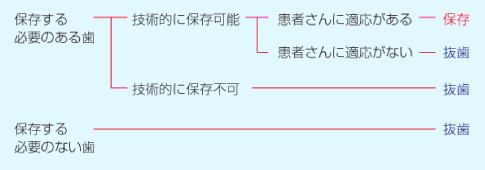What are the criteria for tooth extraction?
Let's think about "Extracting teeth" again.
What causes tooth pain in the first place?
There are two major types of dental disease: dental caries and periodontal disease.
In "dental caries, "mutans bacteria adhere on the tooth surface and produce acid from sugar.
This causes the teeth to dissolve and cold or hot foods begin to sting.
If the tooth becomes severely decayed, it can reach the pulp inside the tooth, causing pain even when you're not doing anything.
But what happens if left untreated?
Bacteria that have reached the pulp will travel through the root canal, the cavity where the pulp used to be, to the the root apex, and finally proliferate in the bone that supports the tooth (Fig. 8).
This is called a "periapical lesion" (Fig. 9), and when this occurs, the tooth begins to move easily.
On the other hand, what is "periodontal disease"?
Periodontal disease is a lifestyle-related disease in which infections left around the teeth cause the bone around the teeth to gradually dissolve, leading to tooth loosening and eventual natural tooth loss.
It is reported that 80% of adults have periodontal disease, and in mild cases, there are almost no symptoms until the disease progresses to the point where the teeth bleed when they are brushed.
However, when the disease becomes more seriously, symptoms such as "pain when chewing" and "swollen gums" suddenly appear, which gradually spread to the entire teeth, making it impossible to eat.
What are the criteria when dentists extract a tooth?
Do you know the criteria by which dentists make the decision that a tooth must be extracted?
A World Heritage Site that is well suited for understanding this is located in the city of Pisa, Italy.
It is the world famous "Leaning Tower of Pisa (Torre di Pisa)" (Figure 11).
It is so famous that there is no one who does not know about this tower, but few people know why it was tilted to its present shape.
Construction of the Leaning Tower of Pisa began in 1173 and took about 200 years until the third construction phase was completed.
The tower began to lean from the first construction phase, and although construction continued to correct the leaning, the leaning did not stop, and the tower has managed to maintain its current appearance by lowering it lower than the original construction plan.
So why did it lean this way?
Were the design drawings bad? No, it was not.
The reason for the tilt is that the soil on the south side of the tower was soft. Over the years, the tower began to lean. It is said that groundwater softened the soil, causing it to tilt more and more.
The same thing can be said for teeth.
The cause of having to extract a tooth is not so much the tooth itself, but the bone that supports the tooth.
The Internet introduces the "criteria for tooth extraction" as follows.
- When dental caries, pulpitis, or periodontal disease is so advanced or there is a periapical lesion that cannot be treated effectively that preservation of the tooth is not possible.
- When it adversely affects adjacent teeth or periodontal tissue
- When the tooth is the cause of odontogenic infection, odontogenic cyst, or odontogenic tumor
- When necessary for orthodontic or prosthetic purposes
- When teeth that interfere with treatment in mandibular and maxillary fractures
- When teeth that stimulate malignancy (From Wikipedia, the free encyclopedia)
In addition, as a matter of common knowledge for us dentists,
a tooth is generally judged to be extracted if it falls into one of the following five categories.
- Teeth that are moving vertically
- Teeth that have been destroyed to the extent that they are hidden in the gums
- Teeth with severely resorbed or fractured tooth-supporting bone(approximately 2/3 resorbed). (Figures 13 and 14)
- Teeth with severely resorbed roots (approximately 1/3 resorbed).
- Teeth that remain painful even after root canal treatment (From "Future Tooth Extraction" by Gakken Shoin)
But don't you wonder?
・What is a tooth that remains in pain even after root canal treatment?
・Is root canal treatment the same for everyone?
・Why does it hurt after the pulp has been removed?
I am sure you have many questions.
Here is one more dental journal.
The criteria for tooth extraction are described as such.
It also concludes with this.
The decision to extract or preserve a tooth is based on...(omitted)...the tooth.
While scientific and technical judgment certainly plays a large part, it is by no means the only factor in making decisions."
Certainly, the inside of the tooth root cannot be seen by you, nor by the treating dentist himself.
Therefore, it is said that the root canal treatment (= professionally, it is called "endodontic treatment") requires abundant knowledge and high skills, and we dentists work hard to train ourselves every day.








